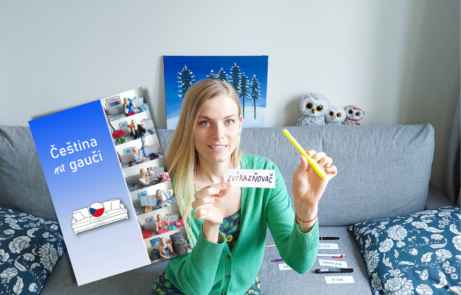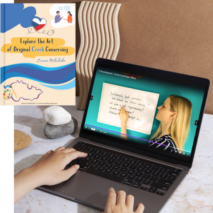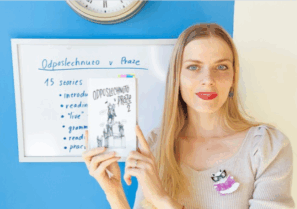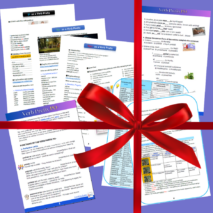Study Guide
If you’re wondering about the best way to use my materials to learn Czech, this guide is for you! Whether you're a complete beginner or already know a little, here’s how you can make the most of my courses, e-books, and worksheets.
Click on the product title and you will be redirected to its link.
Are You a Beginner or a False Beginner?
a) Grammar-light Approach (What is grammar, anyway?)
From A0 to A2. This is for learners who want a smooth introduction into Czech without getting tangled with grammar right away.
Recommended Resources:
- A Fantastic Journey Into the Czech Language & Culture – Udemy video course
- My First Czech Adventure – e-book
- Imperfective Verbs – PDF worksheet
- Perfective Verbs – PDF worksheet
- Čeština na gauči – Udemy video course & e-book
- Explore the Art of Original Czech Conversing – Udemy video course & e-book
My Recommendation:
- Begin with my 12-hour video course A Fantastic Journey Into the Czech Language & Culture – it’s a fun and engaging way to get started and fall in love with Czech.
- Look at the first page of the Imperfective Verbs Worksheet to get a sense of the four basic verb groups.
- Take a look at a few stories from My First Czech Adventure. Read, listen, and observe how verbs are used in context.
- Go back and study the rest of the Imperfective Verbs from the list.
- Explore the Perfective Verbs worksheet.
- Return to My First Czech Adventure, read more stories, and focus on verb usage. Don’t forget to check out the grammar appendix at the end of the e-book if you feel like you are ready for more explanations.
- Čeština na gauči will build your vocabulary. You will learn 120 practical words in context.
- Continue your journey with Explore the Art of Original Czech Conversing – the dialogues will help you pick up practical phrases and improve your listening and speaking skills around the A2 level.
b) Grammar-friendly Approach (Bring it on!)
From A0 to B1. This is for learners who are comfortable with grammar and want a structured understanding of Czech from the start.
Recommended Resources:
- The 100 Most Frequent Czech Verbs – e-book
- Just in Case – e-book
- The 100 Most Frequent Czech Nouns – e-book
Extra support worksheets:
- Imperfective Verbs – PDF Worksheet
- Perfective Verbs – PDF Worksheet
- Conditional Clauses – PDF Worksheet
- Demonstrative Pronouns - PDF Worksheet
You can purchase my Grammar Pack 3-in-1 for a convenient price - you will save 570 CZK! The pack contains:
1. The 100 Most Frequent Czech Verbs
2. The 100 Most Frequent Czech Nouns
3. Just in Case
My Recommendation:
- Start with The 100 Most Frequent Czech Verbs. Listen to the example sentences and get used to Czech word order and sentence structure.
- The 100 Most Frequent Czech Verbs gives you an overview of all the grammatical forms of each verb but if you'd like a different approach and see how the conjugations in present and future are formed, you will find my worksheet on imperfective and perfective verbs very helpful.
- If you want to understand how to use the conditional forms and what aby is, study with the conditionals in my worksheet.
- When you start noticing patterns or feel curious about grammatical cases, it’s time to open Just in Case. Take it at your own pace – you can explore the cases one by one as you feel ready.
- To expand your vocabulary, explore The 100 Most Frequent Czech Nouns. You can study it alongside your case learning – pick a noun and look at how it changes in the cases you've already covered.
(All my grammar resources use the same color-coding system, making it easier and faster to understand the patterns.)


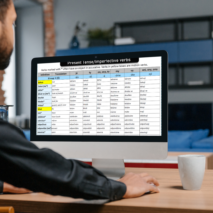
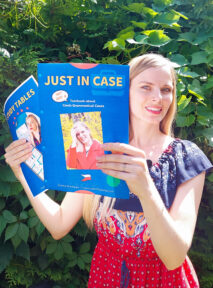
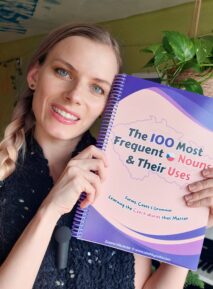
Looking for Something More Advanced?
a) Minimal Grammar – Just Enjoy the Language
From A2 to B2. Whether you prefer a relaxed approach, here are resources for learners at levels A2 and higher.
Recommended Resources:
- When Czech Stories Are Never Better 1 – Udemy video course
- When Czech Stories Are Never Better 2 – Udemy video course
My Recommendation:
- Enjoy reading and listening to real-life stories in When Czech Stories Are Never Better 1. In this video course, I explain key vocabulary and relevant grammar, but the main focus is on understanding informal, everyday Czech. They're perfect for expanding your comprehension and vocabulary in a natural way.
- If you loved the first part, you will love When Czech Stories Are Never Better 2 even more!
b) Grammar-Focused – For the Grammar Enthusiasts
From A2 to B2. If you want to tackle more grammar, these resources for learners at levels A2 and higher.
Recommended Resources:
- The 100 Most Frequent Czech Nouns – e-book
- Demonstrative Pronouns – PDF worksheet
- Conditional Clauses – PDF worksheet
- Verb Prefixes Package – set of PDF worksheets
My Recommendation:
- The 100 Most Frequent Czech Nouns will help you integrate common nouns into your vocabulary and understand how they function across different grammatical cases.
- The Demonstrative Pronouns worksheet will clarify how to use forms like ten, tenhle, tenhleten, or tadyten (including other genders and variations).
- If you're working on mastering verbs, the Conditional Clauses worksheet and Verb Prefixes Package are excellent tools. They'll guide you through verb structure, usage, and meaning changes brought by different prefixes.


